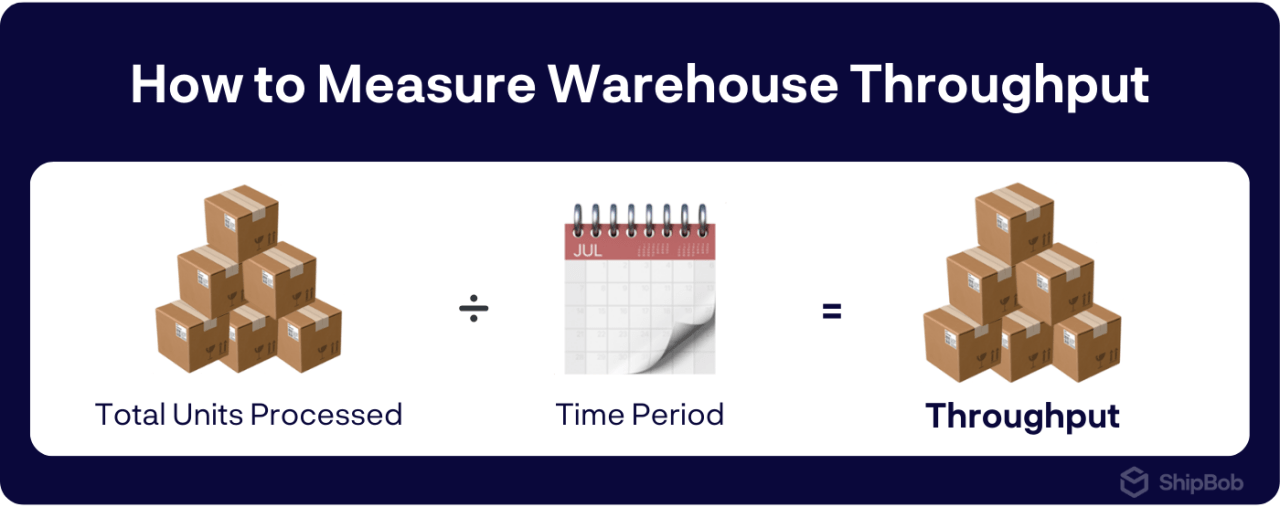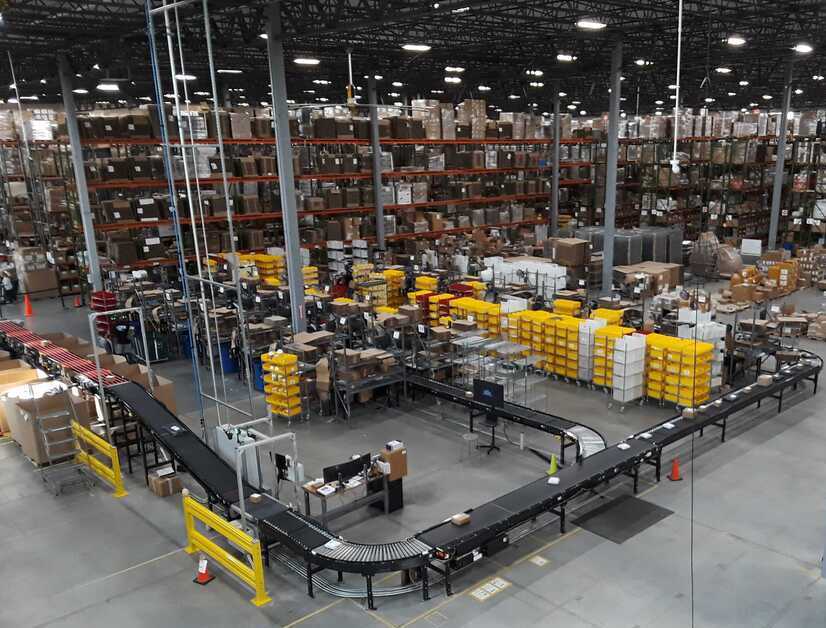Table of Contents
** Minutes
How to measure warehouse throughput
What are the benefits of high warehouse throughput?
5 strategies to improve warehouse throughput
For brands competing in a world where 90% of consumers expect two or three-day delivery, warehouse throughput—the rate at which inventory is processed from receipt to shipment—is a major driver of success. Yet, many businesses struggle with bottlenecks and increasing operational costs due to poor throughput.
At ShipBob, we’ve helped thousands of businesses transform their supply chain performance by optimising warehouse throughput. In this guide, you’ll learn what warehouse throughput means, why it matters, and actionable strategies to improve it.
What is warehouse throughput?
Warehouse throughput measures how efficiently products flow through your facility—from receiving raw materials to shipping orders. It’s calculated by dividing the total number of units processed (e.g., orders shipped) by the amount of time taken to complete those processes. High throughput means your warehouse runs like clockwork, while low throughput signals inefficiencies like slow picking, poor warehouse management, or wasted space.
Importance of measuring and analising warehouse throughput
For ecommerce brands, measuring throughput is not just about speed but also about maintaining accuracy and keeping costs under control. By analising throughput, businesses can:
- Spot inefficiencies in workflows, such as delays in picking processes or miscommunication between departments.
- Improve supply chain performance by ensuring seamless movement of goods from the warehouse to the customer.
- Reduce labour costs by optimising task allocation and minimising redundancies.
How to measure warehouse throughput

To measure warehouse throughput effectively, businesses need to track the movement of goods and calculate specific performance metrics. The most straightforward way to measure throughput is by using this formula:
Throughput = Total units processed / Time period
For example, if your warehouse ships 6,000 orders in a 30-day month, your daily throughput is 200 orders. However, this basic calculation only scratches the surface. To truly optimise, you need granular metrics and tools like a warehouse management system (WMS) to track real-time data.
Key metrics for evaluating throughput
Some important inventory KPIs and metrics for assessing warehouse throughput include:
- Orders per hour: Measuring how many orders are completed within an hour gives insight into operational speed.
- Cycle time: This metric captures the time it takes to complete an order, from picking to shipping. For example, a shorter cycle time indicates greater efficiency.
- Inventory turnover: High inventory turnover shows that products are moving quickly, minimising the risk of overstocking or dead stock.
- Perfect order rate: The percentage of orders shipped without errors. Order accuracy impacts returns and customer trust.
These metrics, when combined with supply chain velocity data, help businesses set benchmarks and identify trends—enabling proactive improvements.
Basic throughput calculation methods
The basic throughput formula mentioned earlier is a good starting point, but businesses can gain even more insights by tracking throughput at a more granular level. Below, are a few examples.
Process-specific throughput
To analyse throughput at different stages (e.g., receiving, packing, shipping), use:
Throughput for a stage = Total units processed in that stage / Time period
Example: A warehouse receiving 10,000 units per day, packing 8,500, and shipping 8,200 shows:
- Receiving throughput = 10,000 units per day
- Packing throughput = 8,500 units per day
- Shipping throughput = 8,200 units per day
Throughput per employee
To measure individual productivity, use:
Employee throughput = Total units processed / Number of employees
Example: If 50 employees process 10,000 orders per day, the average throughput per employee is 200 orders/day (10,000 ÷ 50). If some handle 300 while others manage only 150, targeted training can help improve efficiency.
Throughput per order type or SKU
To evaluate how different products or order types move through the warehouse, calculate:
SKU throughput = Total units processed for a specific SKU / Time period
Order type throughput = Total orders of a specific type / Time period
Example: If SKU A processes 5,000 units in 30 hours, its throughput is 167 units/hour (5,000 ÷ 30). If SKU B processes only 2,500 units in the same time, its throughput is 83 units/hour (2,500 ÷ 30). Slower-moving SKUs may require optimised picking routes or automation.

Check out ShipBob's Warehouse Management System (WMS)
ShipBob's WMS helps your warehouse reduce picking errors, manage inventory in real time, and fulfill orders faster.
What are the benefits of high warehouse throughput?
Optimised warehouse throughput isn’t just about moving goods faster. It’s about improving the entire supply chain and delivering value to customers.
Cost implications of inefficient throughput
Poor throughput can lead to increased labour costs, overstocking, and revenue loss. Inefficient workflows often result in unnecessary delays and errors, further driving up expenses. By improving throughput, businesses can:
- Reduce overtime costs by completing tasks within standard work hours.
- Minimise inventory holding costs by aligning stock levels with demand.
- Avoid rush shipping fees for late deliveries.
Customer satisfaction and delivery speed
High throughput enables businesses to meet the high expectations of today’s customers by shortening order processing times. This translates to fewer missed deadlines, better reviews, and higher customer retention.
For example, a same-day delivery promise is only feasible if the warehouse can process and ship orders within hours of receiving them. Optimised workflows and strategic warehouse setup play a key role in achieving this.
Scalability and business growth
As ecommerce businesses grow, managing higher order volumes can become increasingly complex, with more inventory to handle, more orders to fulfil, and tighter delivery timelines to meet. Optimised throughput ensures that operations can keep pace with demand by maximising the efficiency of each stage in the fulfilment process.

5 strategies to improve warehouse throughput
Improving warehouse throughput requires a mix of strategic planning, technology, and workforce management. Here are actionable steps to help ecommerce businesses boost their throughput:
1. Streamline warehouse operations
Efficient workflows start with an optimised warehouse layout. Organise high-demand products near packing stations and implement zone picking or batch picking to reduce travel time. Additionally, maintaining clear aisles and well-labelled storage areas can help further streamline processes and minimise unnecessary movements.
2. Use a distributed inventory strategy
Storing inventory in multiple fulfilment centres reduces transit times and shipping costs. ShipBob’s Inventory Placement Program (IPP) uses predictive analytics to strategically distribute stock, improving supply chain velocity and throughput. For businesses with fluctuating demand, on-demand warehousing offers flexibility without long-term commitments.
“Having the ability to reduce shipping costs through distributed inventory is probably the difference between profitability and unprofitability for most businesses in the DTC space – so the fact that ShipBob’s network enables brands to do it so easily is a huge differentiator.”
Neil Blewitt, SVP of Operations at Bloom Nutrition
3. Prioritize staff training and workforce management
A well-trained workforce is critical for increasing throughput. Regular training sessions, clear performance metrics, and effective workforce scheduling can drastically improve productivity. Businesses should also consider implementing incentives to motivate employees and maintain high standards.
4. Leverage technology and automation
Warehouse automation is what really sets apart a high-performing order fulfilment operation from a struggling one. Tools like ShipBob’s WMS streamline key processes and provide real-time insights into throughput performance. Automated picking systems, barcode scanners, conveyor belts, and robotics further enhance efficiency by reducing manual effort.
5. Adopt dynamic storage solutions
Flexible storage systems, such as adjustable shelving or mobile racks, adapt to fluctuating inventory levels, ensuring efficient space utilisation. Dynamic storage is particularly valuable for ecommerce warehousing, where seasonal demand spikes are common.
How ShipBob helps you maximise warehouse throughput
ShipBob’s technology-driven solutions are designed to address common throughput challenges and support ecommerce businesses at every stage of growth. Here’s how ShipBob can help:
Advanced warehouse management system
Brands that fulfil orders from their own warehouse can leverage ShipBob’s WMS offers advanced features that streamline operations, such as real-time inventory tracking, automated order routing, and data analytics. These tools reduce errors and enable faster processing, ultimately improving throughput.
“ShipBob WMS is so valuable to our business. The savings we were able to realize in shipping costs alone makes using ShipBob WMS a no-brainer. When you add in the inventory management aspect and global fulfilment centre network, ShipBob WMS has allowed us to grow our sales in a way that we couldn’t before.”
Tom Wall, Vice President of Global Warehousing & Logistics at Beachwaver Co.
Inventory Placement Program
For brands that choose to outsource their brand’s fulfilment to ShipBob (or leverage their own facility and ShipBob’s network for a hybrid fulfilment approach), can benefit from ShipBob’s Inventory Placement Program (IPP).
IPP is an automated inventory placement, distribution, and replenishment solution that ensures products are stored in optimal locations based on demand patterns. By leveraging a distributed inventory strategy, businesses can reduce shipping times and meet customer expectations more efficiently.
Seamless technology integration for data-driven insights
ShipBob partners with popular ecommerce platforms and analytics tools, providing businesses with actionable insights to optimise throughput. These integrations enable brands to easily track key supply chain metrics and make data-driven decisions.
Scalable global fulfilment network
ShipBob’s extensive network of distribution centres supports growth by maintaining high throughput as businesses scale. Whether it’s accommodating seasonal spikes or expanding internationally, ShipBob’s network ensures consistent performance.
Get started with ShipBob
Leverage ShipBob’s global fulfilment network to improve fulfilment operations and enhance your brand’s shipping experience.
Warehouse throughput FAQs
How can ShipBob improve my warehouse throughput?
ShipBob provides a range of solutions, including a powerful WMS, dynamic inventory placement, and seamless integrations, all designed to enhance warehouse throughput.
What factors affect warehouse throughput?
Key factors that affect warehouse throughput include warehouse layout, employee productivity, technology adoption, and warehouse capacity.
How do I calculate warehouse throughput?
Warehouse throughput is calculated by dividing the total units processed (e.g., orders shipped) by the time period (e.g., hours, days). Advanced calculations may also consider specific workflows or SKUs for deeper insights.






